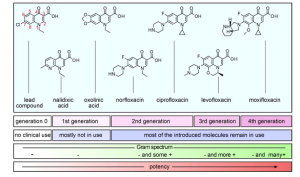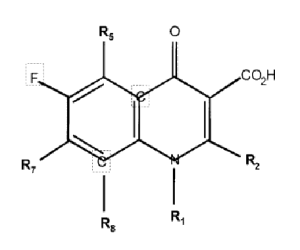Prof. Dr. Hassan Mahmood Mousa Abo Almaali
College of Pharmacy
Quinolones constitute a class of broad-spectrum antibiotics employed for treating diverse bacterial infections. This article provides an overview of their use, mechanism of action, and potential risks associated with quinolone treatment in patients with bacterial infections.
Figure 1: Examples of Quinolone Drug Family Members (Millanao et al., 2021)
Structure activity relationship:
Our understanding of how modifying the core quinolone structure impacts antimicrobial activity has advanced significantly recently. Notably, positions 2, 3, and 4 are crucial for biological activity and cannot be altered without substantial loss. Substituents at positions 5 and 8 influence the planar configuration, with either methyl or methoxy groups appearing most favorable. Investigations suggest hydrogen and amino groups as potential replacements for the fluorine in fluoroquinolones at position 6. However, modifications at positions 5 and 6 of the molecule may not always lead to improved activity within living organisms. Specifically, alterations at positions 7 and 8 of the molecule are critical for preserving potent antimicrobial activity. Fine-tuning the overall molecular structure can achieve this by both enhancing intracellular targets for the drug’s action (such as R-8) and by hindering the function of efflux pumps (like R-7) that limit its intracellular accumulation.
Figure 2: core quinolones structure, molecule indicated with R and numbered from 1 to 8 are sites to be modified in particular quinolones. And atoms in boxes can also be modified.
Indications:
Quinolones, characterized by excellent oral bioavailability, serve as effective treatments for a broad range of bacterial infected patient. However, their usage is limited to specific patients categories groups due to the possibility of severe side effects. Consequently, the FDA discourages the primary use of quinolones unless alternative antibiotics with lower risks of adverse events are unavailable. There are currently four generations of quinolones, with successive generations exhibiting expanded activity against various bacterial strains. And the FDA-approved quinolones were included (moxifloxacin, ciprofloxacin, gemifloxacin, levofloxacin, delafloxacin, and ofloxacin) in addition to others as mentioned by (Mogle et al., 2018).
Quinolones are a versatile tool for treating various adult infections, ranging from urinary tract infections to pneumonia (Aldred et al., 2014). However, their application in children requires a cautious approach due to potential cartilage damage. Consequently, their pediatric use is limited to specific situations like anthrax, plague, and complex urinary tract infections, with only certain quinolones like ciprofloxacin being FDA-approved for these cases (Jackson and Schutze, 2016; Patel and Goldman, 2016).
Mode of Action:
Quinolones belong to a class of drugs known for their antibiotic properties, effectively eliminating bacterial cells. They function by inhibiting specific enzymes, namely type II bacterial topoisomerases, DNA gyrase, and topoisomerase IV. By obstructing these enzymes, quinolones initiate a sequence resulting in permanent double-strand breaks within the bacterial chromosome. Consequently, this leads to the demise of the bacterial cells (Yefet et al., 2018). Despite their effectiveness, the rising incidence of bacterial resistance to quinolones is a growing concern, with documented resistance mechanisms including enzyme-mediated, plasmid-mediated, and chromosome-mediated resistance (Tyson et al., 2019).
Administration Methods:
For oral administration, quinolones shine. They get taken up quickly in the gut and reach high levels in the body, making them powerful weapons against infections (Mant, 1992).The distribution of quinolones throughout the body varies based on their chemical properties, influencing their penetration into tissues and body fluids. Elimination primarily occurs through the kidneys, with hepatic and intestinal routes playing a lesser role (Naidoo et al., 2017).
Adverse Effects:
Common adverse effects of quinolones encompass gastrointestinal issues, antibiotic-associated colitis, joint pain (especially in children), and various allergic and skin reactions. Addressing the infrequent yet severe adverse outcomes encompasses tendinopathy, tendon rupture, and a variety of significant side effects. These adverse effects encompass the following; QTc prolongation, in addition to hepatotoxicity, dysglycemia, neuropathy, ocular toxicity, aortic aneurysm, and exacerbation of myasthenia gravis (Stahlmann and Lode, 2010; Rawla et al., 2019).
Contraindications:
These antibiotics aren’t usually given to pregnant women or children because they might affect growing bones and joints. Limited safety studies exist for quinolone use in children, While some users experienced arthropathy or musculoskeletal concerns, these issues seemed to resolve themselves once they stopped taking the drug. (Jackson and Schutze, 2016). In pregnant women, caution is advised, considering theoretical concerns about inhibiting fetal DNA synthesis. The use of quinolones in the first trimester raises uncertainty due to potential teratogenic effects observed in animal experiments, despite lacking conclusive evidence in humans. Therefore, caution is necessary, especially during the sensitive early stages of pregnancy (Ziv A et al., 2018).
References:
Jackson MA, Schutze GE., committee on infectious diseases. The Use of Systemic and Topical Fluoroquinolones. Pediatrics. 2016 Nov; 138(5)1.
Lance R. Peterson, Quinolone Molecular Structure-Activity Relationships: What We Have Learned about Improving Antimicrobial Activity, Clinical Infectious Diseases, Volume 33, Issue Supplement 3, September 2001, Pages S180–S186.
Mant TG. Multiple-dose pharmacokinetics of lomefloxacin: rationale for once-a-day dosing. Am J Med. 1992 Apr 06; 92(4A):26S-32S.
Millanao AR, Mora AY, Villagra NA, Bucarey SA, Hidalgo AA. Biological Effects of Quinolones: A Family of Broad-Spectrum Antimicrobial Agents. Molecules. 2021; 26(23):7153.
Mogle BT, Steele JM, Thomas SJ, Bohan KH, Kufel WD. Clinical review of delafloxacin: a novel anionic fluoroquinolone. J Antimicrob Chemother. 2018 Jun 01; 73(6):1439-1451.
Naidoo A, Naidoo K, McIlleron H, Essack S, Padayatchi N. A Review of Moxifloxacin for the Treatment of Drug-Susceptible Tuberculosis. J Clin Pharmacol. 2017 Nov; 57(11):1369-1386.
Patel K, Goldman JL. Safety Concerns Surrounding Quinolone Use in Children. J Clin Pharmacol. 2016 Sep; 56(9):1060-75.
Pham TDM, Ziora ZM, Blaskovich MAT. Quinolone antibiotics. Medchemcomm. 2019 Oct 01; 10(10):1719-1739.
Rawla P, El Helou ML, Vellipuram AR. Fluoroquinolones and the Risk of Aortic Aneurysm or Aortic Dissection: A Systematic Review and Meta-Analysis. Cardiovasc Hematol Agents Med Chem. 2019; 17(1):3-10.
Stahlmann R, Lode H. Safety considerations of fluoroquinolones in the elderly: an update. Drugs Aging. 2010 Mar 01; 27(3):193-209.
Tyson GH, Li C, Hsu CH, Bodeis-Jones S, McDermott PF. Diverse Fluoroquinolone Resistance Plasmids From Retail Meat E. coli in the United States. Front Microbiol. 2019; 10:2826.
Yefet E, Schwartz N, Chazan B, Salim R, Romano S, Nachum Z. The safety of quinolones and fluoroquinolones in pregnancy: a meta-analysis. BJOG. 2018 Aug; 125(9):1069-1076.
Ziv A, Masarwa R, Perlman A, Ziv D, Matok I. Pregnancy Outcomes Following Exposure to Quinolone Antibiotics – a Systematic-Review and Meta-Analysis. Pharm Res. 2018 Mar 26; 35(5):109.































































